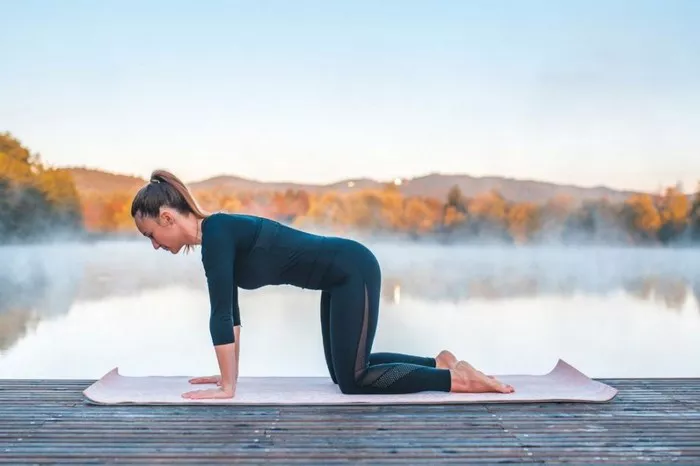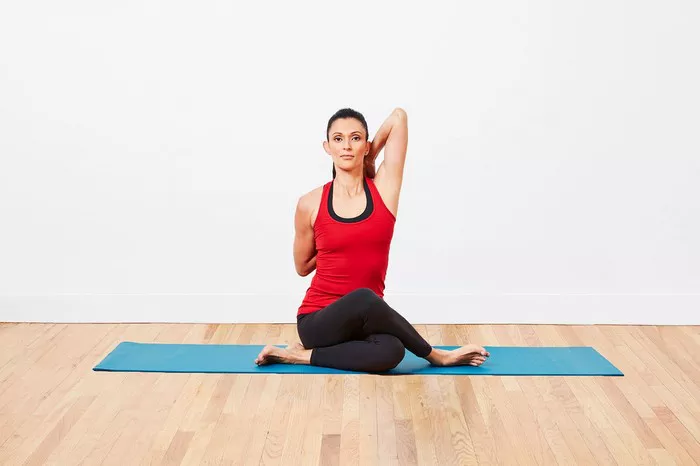Fish Pose, or Matsyasana, is one of the most beloved and energizing postures in the world of yoga. It might seem simple at first glance, but the profound impact it has on the body and mind is undeniable. Whether you’re a seasoned yogi or a beginner, practicing Matsyasana can bring a wave of relief, release, and invigoration. In this article, we will explore the anatomy, benefits, and overall effect of Fish Pose on the body, as well as why it feels so good when you incorporate it into your yoga practice.
Understanding the Fish Pose (Matsyasana)
Matsyasana is a backbend yoga pose that opens the chest and stretches the entire front of the body. The name “Matsyasana” comes from the Sanskrit word “Matsya,” meaning fish, and “asana,” meaning posture or seat. When you perform the pose correctly, your body resembles the shape of a fish, with your chest lifting upwards, your head tilting backward, and your body curving into an arch.
To enter Fish Pose, you begin by lying on your back with your legs extended on the floor. The arms are typically placed under the body, palms down, as you lift your chest and arch your back. Your head gently drops back, with the crown of your head resting on the floor. The feet remain flat or lightly pointed, and the spine extends through the curve of the backbend. The key to Fish Pose is lifting through the chest while keeping the lower body grounded.
While the pose may initially feel challenging for some, especially in the chest and neck area, the rewards are immediate and long-lasting.
The Physical Benefits of Fish Pose
1. Improved Posture and Spinal Flexibility
Fish Pose offers an incredible stretch for the spine. By arching your back and lifting your chest, you create an expansion through your thoracic (upper) spine, which is often stiff due to poor posture and daily activities like sitting for long periods.
Practicing this pose regularly helps increase spinal flexibility and encourages an upright posture. This can be especially beneficial for those who spend long hours sitting at a desk or in front of a screen. Over time, Matsyasana can reduce the curvature of the spine and alleviate the pressure caused by poor alignment.
2. Chest Opening and Lung Expansion
One of the most noticeable effects of Fish Pose is the intense stretch across the chest and shoulders. As you lift your chest towards the sky and tilt your head back, the front of your body opens, allowing you to breathe deeper and more freely.
This chest-opening action can help counteract the rounded shoulders and tightness in the upper back that many people experience from modern-day habits. It increases lung capacity by stretching the intercostal muscles (the muscles between the ribs), which leads to better oxygen intake. It can also improve your breathing patterns and promote relaxation.
3. Stimulation of the Thyroid and Parathyroid Glands
Matsyasana has a significant effect on the thyroid and parathyroid glands, which are located in the neck. When you tilt your head back and create a stretch in the neck, you stimulate these glands, helping to regulate hormones related to metabolism and energy. The thyroid is responsible for controlling the body’s metabolic processes, and a healthy, balanced thyroid can promote overall wellness.
4. Stretching and Strengthening the Neck, Shoulders, and Spine
While Matsyasana primarily focuses on stretching the chest and spine, it also strengthens and stretches the muscles of the neck and shoulders. The position of the head and neck in this pose encourages gentle stretching of the cervical spine, which can help to relieve tension in the neck and shoulders.
For people who hold stress in their upper body, this pose offers significant relief. It also helps with the alignment and strength of the cervical spine, potentially alleviating neck pain and improving posture.
5. Increased Circulation and Improved Blood Flow
Fish Pose stimulates circulation in the upper body, especially in the chest, shoulders, and neck. By creating space in the chest, the flow of blood and oxygen to the heart and lungs is enhanced. The increased circulation can help reduce fatigue, boost energy, and improve overall vitality.
Additionally, Matsyasana can be therapeutic for those with conditions such as asthma, by opening the lungs and improving oxygen intake. The pose encourages deeper breathing, which in turn improves the oxygenation of the blood and supports detoxification.
6. Release of Tension in the Back and Lower Body
Fish Pose has a subtle but significant effect on the lower body as well. The active engagement of the legs, feet, and hips while pressing into the mat helps lengthen the spine. As you lift through the chest and arch your back, you release tension in the lower back and stretch the hip flexors.
The pose can also provide relief from lower back pain, especially if the discomfort is caused by tightness in the hip flexors or poor posture. By stretching the lower body and aligning the spine, you create a harmonious flow of energy throughout the body.
The Mental and Emotional Benefits of Fish Pose
In addition to its physical benefits, Fish Pose offers profound mental and emotional advantages. Yoga is often referred to as a practice that harmonizes the mind and body, and Matsyasana is no exception. By engaging in Fish Pose, you can experience several emotional and psychological benefits:
1. Stress Relief and Relaxation
The chest-opening nature of Matsyasana is known to release stored tension and emotions. This can be particularly helpful for people who tend to hold stress and anxiety in their upper body. By opening the chest and expanding the lungs, the pose can trigger a relaxation response, calming the nervous system.
The practice of deep breathing, which accompanies this pose, can activate the parasympathetic nervous system—also known as the “rest and digest” system—helping you enter a state of relaxation. Many students report feeling a sense of emotional release after holding Matsyasana, as it encourages them to let go of tension both physically and mentally.
2. Heightened Awareness and Clarity
When performed mindfully, Fish Pose can lead to a heightened sense of awareness. The stretching and opening of the chest promotes a sense of clarity and focus, which can carry over into your mental state. You might find that, after a session of yoga with Fish Pose, your mind feels clearer, your thoughts more organized, and your emotional state more balanced.
3. Invigoration and Energy Boost
Fish Pose is an energizing backbend. Unlike other postures that may feel relaxing or restorative, Matsyasana can feel quite invigorating. By stimulating the heart and lungs, and allowing for deep breaths, the pose can boost circulation and oxygenate the body, leaving you with a feeling of renewed energy.
This burst of energy is often felt in the chest and upper body, making it a great way to counteract sluggishness or fatigue. It helps to shake off feelings of mental exhaustion and gives you a burst of vitality that can last for hours after the practice.
4. Emotional Release and Vulnerability
The chest-opening nature of the pose also taps into the heart chakra, the energy center associated with love, compassion, and vulnerability. By opening the chest and exposing the heart, Fish Pose allows practitioners to release emotional blockages. This can lead to emotional healing, as well as greater openness in relationships with others.
Many people find that this pose fosters a sense of vulnerability, which is an essential aspect of personal growth. The release of built-up emotions during the practice can create a deep sense of emotional freedom and peace.
Why Fish Pose Feels So Good: The Power of the Breath
One of the most significant factors in why Fish Pose feels so good is the breath. Yoga, at its core, is about creating a harmonious flow between breath and movement. When you practice Matsyasana, your breath deepens as you open up your chest, allowing for more expansive inhales and exhales. The act of breathing deeply into the chest is not only physically nourishing but emotionally soothing as well.
The breath helps to create a deeper connection to the body, enhancing the effects of the posture. By syncing the breath with the movement of the body, you facilitate the release of tension, reduce stress, and heighten the sense of invigoration and relaxation. It is this combination of stretching, alignment, and breathwork that makes Fish Pose such a powerful and enjoyable pose to practice.
Tips for Practicing Fish Pose
To make the most out of Fish Pose and avoid strain, here are a few tips:
Start Slowly: If you’re new to backbends, it’s important to ease into Fish Pose. Take your time to lift the chest, and do not force your neck back too far.
Keep the Neck Relaxed: Avoid straining your neck by gently letting your head drop back. The weight of your head should be supported by the floor, and there should be no pressure on the cervical spine.
Engage the Legs: Press your legs into the mat as you lift your chest. This will help protect your lower back and enhance the stretch in your upper body.
Breathe Deeply: Use your breath to guide the movement, inhaling as you lift your chest and exhaling as you relax into the pose.
Conclusion
Fish Pose (Matsyasana) is an incredibly rewarding pose that can leave you feeling physically stretched, emotionally open, and mentally clear. The physical benefits, including improved posture, spinal flexibility, and chest expansion, are complemented by the emotional and mental benefits of stress relief, invigoration, and emotional release. The combination of deep breathing, spinal extension, and chest opening contributes to the profound sense of well-being that many practitioners experience when practicing this pose.
The next time you step onto your mat and enter Fish Pose, take a moment to savor the sensation it creates in your body and mind. Allow yourself to fully embrace the stretch and openness, and enjoy the wonderful feeling that comes with it. Matsyasana is a simple yet powerful posture that can significantly enhance your yoga practice and contribute to your overall sense of health, vitality, and peace.
Related Topics:


























